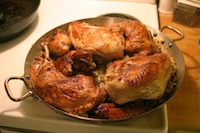Summer has been slow to reach the Lower Mainland of British Columbia, and the natives have been getting restless. While we are sweating our asses off in India all winter, they are slogging through cold, grey, short days. The folks here seem relived and excited, in equal measure, that the cloudless skies of summer finally seem to have arrived.
My major disappointment about the unseasonably cold June is that the blackberries, which grow in such profusion here, will be slow to ripen. Fortunately, the fabulous salmonberry is now ripe for the plucking.
As I was riding my mountain bike along the forest trails of Pacific Spirit Park yesterday, I noticed two women wading into the brambles picking berries. Three quarters of an hour later, when I passed back through the same area, I saw them still at it; so I stopped to investigate. “It’s the yellow ones,” they told me. I devoured a satisfying dozen-or-so and sped off down the hill, resolved to return.
The “yellow ones” turn out to be salmonberries, Rubus spectabilis, related to raspberries and found growing in the coastal forests from Alaska to Northern California. The fruit is decidedly subtle, compared to the tang and sugar of raspberries or blackberries, but it has a sufficient sweetness, an earthiness, and a redolence of the forest pollens which are quite satisfying.
This afternoon, Yoo-Mi and I wandered back into the forest, buckets in hand, to harvest salmonberries. Thirty minutes later, we had enough for a batch of salmonberry jam, which we made this evening.
This may seem an act of over-the-top domesticity for someone who normally procures his jams from Fauchon and Hediard; but it’s quite in keeping with our life here in Vancouver. In addition to the normal, daily shopping-and-cooking, we brine and cold-smoke our own salmon, stuff-and-fold our own won ton, bake our own desserts, and make our own yogurt fresh each day. The latter activity not only produces excellent curds, but it eliminates considerable single-use plastic waste from yogurt containers. (We buy our milk from the local Avalon Dairy, in returnable glass bottles, which also eliminates the tetra pak waste.)
We aren’t yet baking out own bread – the stuff from Transylvania Bakery is just too good – but if you stop by for morning toast (and yoghurt), it’ll be served with our new salmonberry jam.
Before
After (Note the reused jar from Fauchon)










Now I’m motivated to make my own yoghurt – thanks for the inspiration Mark!
Mark,
Please save me a spoonful of that salmonberry jam (and some of the smoked non-berry of the same name). I’m hoping to visit around the end of September, right around when I visit Seattle. Will you guys still be up there?
Read this when you first published it and the concept blew my mind– making your own yogurt? But I eat it often and the amount of little plastic tubs I inherit is distressing and I’ve been unable to find anyone who sells yogurt in glass. I’m experimenting with my own salsas currently but was wondering if you might have a good recipe/process for making your own yogurt that you might be able to recommend? When I’m ready to try I would like to be on solid footing so there’s less opportunity for extreme disappointment to dissuade any future experiments.
Blaark:
Making yogurt couldn’t be easier; the bacteria does most of the work for you.
Think of it as a four step process: sterilize, inoculate, incubate, refrigerate.
Step One: sterilize the milk to ensure that you’ve rid yourself of all unwanted bacteria. Simply heat your milk (I prefer whole milk) to 85° C (195°F). If you are fancy, have time to kill, and like to use lots of pots, use a double-boiler arrangement to avoid scorching the bottom. If you are like me, do it over low direct heat and stir vigilantly. You’ll want to use a thermometer to get the temp right in the early going; but, after a while, you’ll recognize that the milk starts to steam at 85°C and you’ll leave the thermometer in the drawer – one less thing to clean.
Step Two: inoculate the milk with lactobacillus and other bacteria which will transform your milk into curds. Where can you find these organisms? In an existing batch of yogurt itself, of course! After you’ve made your first batch, you can reserve 100ml-or-more per liter of milk (about one cup cup per gallon) to use as your starter. Initially (or if your last batch has been sitting in the refrigerator for a week and may have lost its potency), use fresh, store-bought, unflavored yogurt.
Two things will give you a nice, even inoculation. First, be sure to bring the temp down to 40° – 45°C (approximately 110°F) before you add the live starter. The same high temp that you used to kill the unwanted shit will kill the good shit too. Use the thermometer until you are able to do this by touch. Second, give the starter a good stir to liquefy it – and even add a bit of the warmed milk to dilute and de-lump it before dumping it into the milk. The more evenly you are able to whisk the starter into the milk, the smoother the resulting culture.
I usually make one liter at a time, and do so in a single ceramic bowl. Some folks use individually portioned jars or bowls, which seems like more work and mess than necessary. Be sure to sterilize whatever vessel you use with a splash of boiling water to ensure that the bacteria you will be growing in the next step are the ones you want, and not any undesirables.
Step Three: set the inoculated milk aside for 4 to 8 hours to incubate. For the bacteria to multiply as per plan, you will want to supply them with a warm, happy place. Warm means somewhere between 40° – 45°C (say, 100° – 110°F). Happy means still and covered. (Since I culture my curds in a single bowl, I simply use a ceramic plate as the lid.) Some people simply place the inoculated milk in a turned-off, slightly warmed oven. Some use a cooler pre-warmed with a bit of boiling water and kept at temp by a few jars of hot water. If you live in a place like India, as I do half of each year, you can simply leave it out on the kitchen counter. In Vancouver, where things are just a bit less balmy, I use a cooler which I have rigged with an old heating pad and towels (the heat from the pad, even on its lowest setting is a bit too high to put in direct contact with the bowl). Again, you will probably want to use your thermometer in the early going to find an incubation environment that keeps the temp in the desired growth range.
Step Four: refrigerate the curds to stop the incubation process and allow the yogurt to set. It will not be as firm as you might expect until you refrigerate it. The key aspect of this process is not simply reducing the temp to a palate-friendly chill; the idea is to stop the bacteria from multiplying (which they do in logarithmic phase) and to keep them alive in the retarded animation of refrigeration.
This is not only a great way to reduce consumption of single-use plastic yogurt containers, it is an easy way to keep fresh curds on-hand. In Vancouver, we are able to buy our milk in returnable glass bottles, which further reduces the amount of waste produced as a by-product of your morning yogurt habit.
And if you do as we do, and use your homemade jams to sweeten and flavor your yogurt, then you are really onto something! Next we’ll have to start baking our own granola — also easy.
Cheers,
MBJ
Wow, that’s awesome, thanks so much! The plastic containers are the reason homemade yogurt even appealed to me so I’ll be seeking out milk bottles which are lingering around last I checked… Baking granola seems more of a pipe dream considering the amount of ingredients I’m accustomed to but maybe one day…
Now let’s see if I can give myself dysentery trying this out… Thanks again!
MBJ:
Regarding the boiling the milk step: One thing I discovered in India is that if you are using whole milk, it actually scorches less if you heat it on a higher flame. You don’t have to stir it quite as much either. I think it has something to do with dissolving the fat in the milk faster, which has a non-stick effect…. Lowfat and nonfat milk are trickier, of course. Some people boil their milk in the microwave, which seems to work just as well with no scorching.
-s
I want buy some bottles for jam purpose.